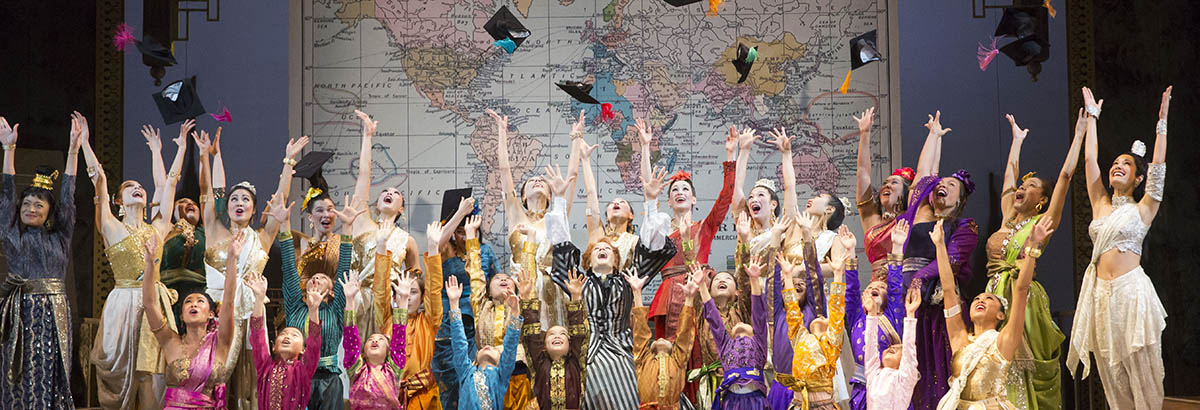May 28, 2020
A Glorious Partnership: The Hero and Heroine of THE KING AND I
Certain duo title roles in opera require a chemistry onstage that can make all the difference in performance. Whether it’s Tristan and Isolde or Romeo and Juliet, give-and-take and sheer electricity between the two can ignite a special excitement in an audience. Turning to musical theater, we find a similarly exceptional pairing in the protagonists of The King and I. Unlike the above-mentioned couples, King Mongkut of Siam and the “I” of the title, Anna Leonowens, aren’t lovers (although there’s potential there – see below!), but if we’re talking about a palpable connection between performers in a musical, Anna and the king are really in a class by themselves.
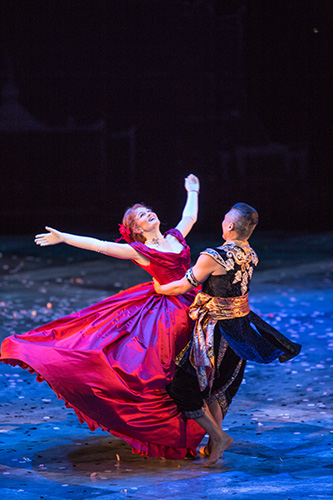
Kate Baldwin and Paolo Montalban in Lyric' 2015/16 The King and I.
From their strained first meeting right to the end of the show, each scene between these two develops the relationship in a memorable way. They try each other’s patience, to the point where the king on numerous occasions loses his temper with Anna (he remembers this in the painfully honest letter he sends her when she is about to leave Siam). Each possesses acute intelligence, and from their first moment together the ruler and the teacher are truly curious about each other. The clashing of cultures and backgrounds is crucial in other Rodgers and Hammerstein shows (think of the American nurse and the French planter in South Pacific, or the assimilated young Chinese-Americans and their traditionally-minded relatives in Flower Drum Song), but that tension is most powerfully present in the sparring between Anna and the king.
Other than his brief sung responses to Anna in the “Shall We Dance?” scene in Act Two, the king, surprisingly, is given only one solo, “A Puzzlement.” This number, however, is certainly remarkable in its revelation of an outwardly confident monarch’s insecurity and self-doubt, particularly regarding how he can best prepare his son, the crown prince, who will succeed him.
Anna has the lion’s share of music in the show. Besides “Shall We Dance?” Rodgers and Hammerstein give her four other songs, which immeasurably enhance this rich, well-rounded character: “I Whistle a Happy Tune” and “Getting to Know You,” abundant with positiveness, energy, and lovability; “Hello, Young Lovers,” with its ineffably sad aura of romantic nostalgia; and the half-sung/half-spoken soliloquy, “Shall I Tell You What I Think of You?,”in which Anna’s feistiness emerges very strongly indeed. Perhaps the latter number is the one that most thoroughly communicates the spirit of the real-life Anna Leonowens, a woman who definitely knew her own mind and could take care of herself.
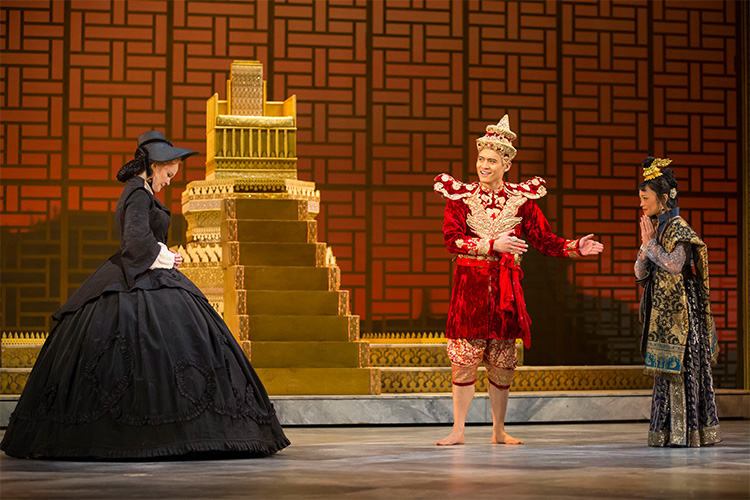
Kate Baldwin and Paolo Montalban in Lyric' 2015/16 The King and I.
Anna Harriet Emma Edwards was born in India to a cabinetmaker who enlisted in the Bombay infantry with his Anglo-Indian wife. Their daughter, educated in England, returned to India in her mid-teens. She later took great pains to disguise her mixed-race heritage, in order to improve opportunities available to her and her children. Anna managed to pass as a Victorian lady in Singapore. This was possible thanks to some very basic changes she made in facts about her life, including her age, her birthplace, her mother’s Indian parentage, and her father’s military rank.
Rodgers and Hammerstein’s Anna speaks and sings of Tom, her late husband. The real-life Tom’s full name was Thomas Leon Owens (“Leonowens” was yet another fabrication by Anna). Born in Ireland and raised in India, he was a clerk whom Anna married when she was 18. They were a peripatetic couple who lived in various Australian towns before relocating to Malaysia. Anna was left alone there when Tom died of apoplexy in 1859. Children of British officers were taught by Anna in Singapore, and it was there that she received the offer made by the King of Siam. She must have possessed astounding self-confidence to take on the job of single handedly teaching not only the king’s 82 children, but also his 39 wives and concubines. In Rodgers and Hammerstein’s version of Anna’s story, she has only one child, Louis. In real-life, there was also a daughter, Avis, sent to an English boarding school when Anna left Singapore for Siam. Having spent five years in Bangkok, Anna then moved to America, writing her books there and becoming a celebrated lecturer. Her travels abroad continued, and she also made her mark as an ardent feminist. Eventually she settled in Canada, dying in Montreal at age 83 in 1915.
As for Anna’s opposite number in The King and I, it comes as a surprise that Mongkut actually spent much of his adult life as a Buddhist monk. He didn’t actually assume the throne of Siam until 1851, when he was already 47. Rodgers and Hammerstein were true to the real king in presenting him as a figure very much interested in creating ties with his fellow leaders worldwide. Among the addressees of his many hundreds of letters were three U.S. presidents, as well as distinguished figures ranging from Queen Victoria to Pope Pius IX.
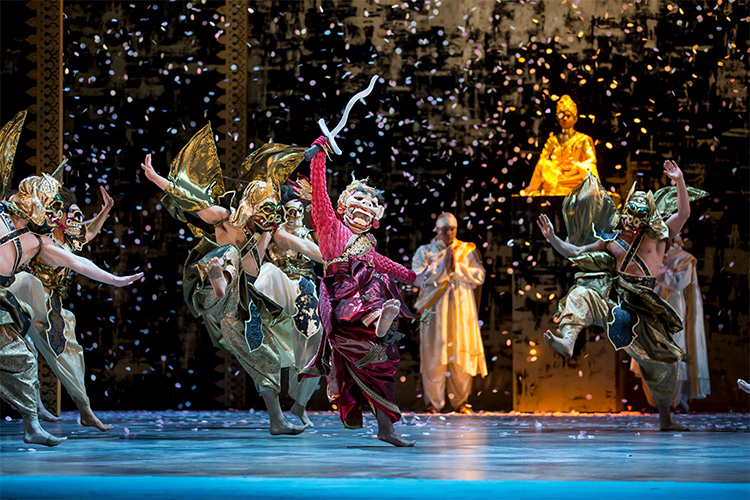
The cast of Lyric's 2015/16 The King and I.
Anna’s retelling of her experiences in Mongkut’s court came to public attention not just through her lecturing activities but also via two memoirs, The English Governess at the Siamese Court (1870) and Romance of the Harem (1873). An American writer, Wisconsin native Margaret Landon (1903-1993), turned Anna’s time in Bangkok into an engrossing historical novel, Anna and the King of Siam (1944). It was inevitable that the book would inspire interest from Hollywood. Indeed, just two years after the book appeared, Twentieth-Century Fox released a lavish (albeit black-and-white) film adaptation, with Irene Dunne as a notably lively Anna and Rex Harrison who, according to the New York Times review, beautifully presented the king’s “quaintly eccentric nature, his difficult comprehensions of new thought, his pride and his poignant humility.”
It was Landon’s book that attracted the next major figure in The King and I’s path to the stage. She was one of England’s greatest gifts to Broadway, and a star like no other of her time. Gertrude Lawrence exuded a personal radiance that drew audiences to her like moths to a flame. She was celebrated in New York and London for plays written by and costarring Noël Coward, but during her Broadway career she triumphed in a number of non-Coward shows, including two musicals—George Gershwin’s Oh, Kay! (1926) and Kurt Weill’s Lady in the Dark (1941).
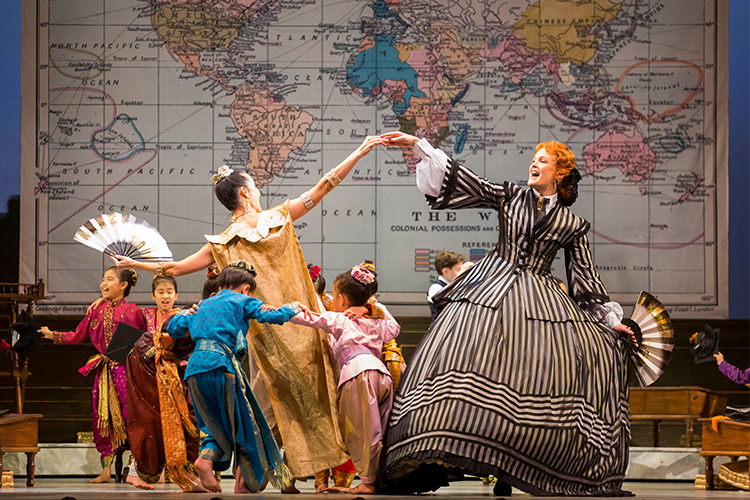
Kate Baldwin in Lyric's 2015/16 The King and I.
By the late 1940s, Lawrence’s stature in the theatrical world was such that any writer would have jumped at the chance to create a show for her. In 1949, a year after appearing on Broadway in Coward’s Tonight at 8:30, Lawrence read Anna and the King of Siam. She immediately saw herself as Anna, whether in a straight play or a musical. The actress bought the rights and had her agent, the lawyer Fanny Holtzmann, seek out likely candidates who could mold the story into a vehicle for Lawrence’s next Broadway venture.
Another influential woman now entered the picture: Dorothy Hammerstein, the lyricist’s wife, whom Holtzmann persuaded to bring Landon’s book to her husband’s attention. This she did, with Hammerstein finding himself interested but with some reservations. Only after he and Rodgers saw the film did they see how a stage version could take shape. They signed on to the project, with Lawrence set to play Anna.
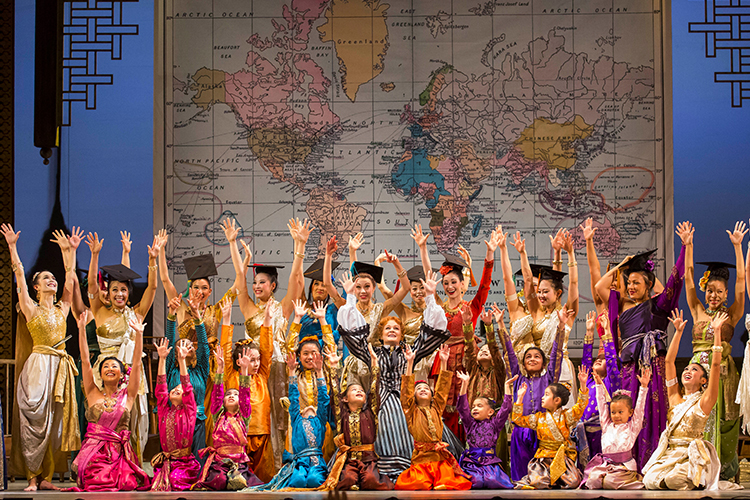
The cast of Lyric's 2015/16 The King and I.
WIth their leading lady all set, what about the leading man? They owed their choice to Mary Martin, who in 1946 had starred in the short-lived musical Lute Song. She appeared opposite a Russian-born actor in his mid-twenties, born Yuly Borisovich Briner but known by this time as Yul Brynner. He impressed Martin, and four years later, upon hearing that Rodgers and Hammerstein had yet to find a king, she heartily recommended her former costar. Richard Rodgers recalled that at his audition, Brynner “scowled in our direction…there was no denying that he projected a feeling of controlled ferocity.” Here was the actor born to play the king.
The libretto includes a subplot involving the star-crossed lovers, Tuptim and Lun Tha. No doubt audiences would be craving a love story between Anna and the king as well, but initially Hammerstein’s text gave not even a hint of one. This was all too clear to Brynner early on. More than a quarter-century later, he spoke of the pre-Broadway tryout in New Haven, where he realized that throughout the show the audience was seeing only conflict between the king and Anna:
After the show, which lasted about five hours and was obviously a flop, I took Gertrude Lawrence to supper, alone, and I said, 'Darling, from now on, from the moment you come into my palace, from the moment we are together onstage, we are going to play a great love story, through conflict, through everything.' So she said, 'Well, we’ll try. I don’t see how, but we’ll try.'
Brynner went on to recall the Boston tryout, in which Hammerstein, with his expert theatrical eye, saw what the couple was doing onstage:
And out of that came his writing of the whole section that surrounds 'Shall We Dance?' She finds the king reading poetry, he tells her what nonsense the English poets write about 'love, etcetera, etcetera, etcetera.' And that leads into 'Shall We Dance?' which is really as close to being a love scene between them as anything can be. It was marvelous to see how these things happen, how Rodgers could write 'Shall We Dance?' in something like three or four minutes. That’s the length of time it takes to play it–and that’s how fast he wrote it.
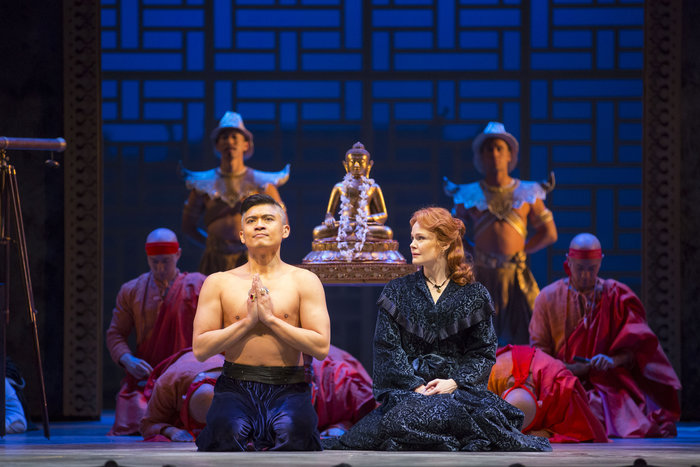
Kate Baldwin and Paolo Montalban in Lyric's 2015/16 The King and I.
Lawrence’s insecurity in her singing upset Rodgers and Hammerstein greatly (they even seriously considered firing her), but she was saved by her natural charisma and audiences’ devotion to her. She played the role for a year and a half, winning a Tony Award, as did Brynner (the show also won for Best Musical, and for its set and costume designers), but sadly, after a matinee during the hot summer of 1952, Lawrence collapsed. A month later she succumbed to liver cancer; one of her final requests was that Brynner receive star billing as the king. Lawrence was buried wearing the ball gown in which she had enraptured audiences when singing “Shall We Dance?”.
Indelibly associated with the king, Brynner played the role for three years in its original Broadway run, in two Broadway revivals, and nationally and internationally, with a staggering career total of 4,625 performances in the role. His portrayal is familiar to millions through the magnificent film version of The King and I, for which he earned an Oscar as Best Actor in 1957. Nominated as Best Actress was Brynner’s captivating onscreen partner, Deborah Kerr, who had already played Anna on the radio in a 30-minute adaptation broadcast on the Hallmark Playhouse in 1949.
Rodgers’s soaring lyricism matched with Hammerstein’s exquisite lyrics, the show’s visual spectacle, the irresistible “Small House of Uncle Thomas” ballet, the electricity of Robert Russell Bennett’s superb orchestration—all of this adds luster to The King and I. For those who see and hear it in the theater, however, what surely remains longest in the memory is the couple at the show’s heart. In musical theater there is no emotional journey more overwhelming for an audience than that of Anna and the king as they travel from seemingly insurmountable conflict to respect, admiration, and yes, love.
Photos: Todd Rosenberg
